


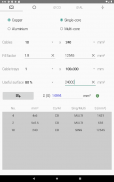
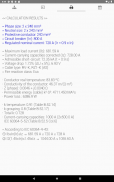

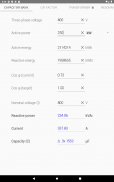
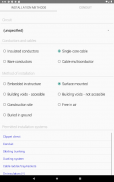








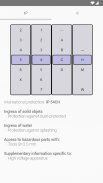


InstElectric - Electricity

توضیحات InstElectric - Electricity
Tool to support the calculation of electrical installations that will allow the user (designer / electrician / technician) to perform electrical calculations easily and quickly.
· Dimensioning complete of low voltage circuits with the most frequent installation methods
· Phase cable size, neutral, protective conductor
· Criteria based on the admissible current of the cable, voltage drop and overcurrent protection
· Designation of the most used cables.
· Circuits with automatic circuit breaker until In = 4000 A (Ir rating setting), maximum fuse In = 1600 A (gG type), maximum 12 conductors parallel per phase, maximum size 630 mm²
· Estimate of the maximum short-circuit current (simplified method)
· Forecast of loads of a building destined to houses with several sections: dwellings, common services, commercial premises/offices and garage with/without infrastructure for recharging electric vehicles
· Reactive power of the capacitor bank for the compensation of the power factor (cos φ) and capacity (µF) of the capacitors
· C/K Factor for automatic capacitor bank
· Choice of installation system in the function of the circuit, cable and its situation
· Power in an unbalanced three-phase system
· Overvoltages due to loss of neutral conductor, earth fault and short circuit
· Electricity parameters of a single-phase or three-phase (balanced)
· Transformer performance
· Secondary voltage of a transformer acoording to switch position
· Size of trays and conduits
· Conduits characteristics according to the installation method
· Conversions of wire sizes (mm²-awg) and conduits threads
Parameter settings for calculations:
· Constants (voltages, conductivity, temperatures, etc.) that affect electrical calculations
· Protections (circuit breakers and fuses)
· Selection of minimum rate for circuit-breakers with regulation and maximum cable size for multi-conductor grouping per phase
· Method estimation of the reactance
· Conductivity of the conductor depending on the current of the circuit (constant, according to the expected current, maximum cable temperature)
· Use reduction factors by grouping cables/circuits
· Use of factors of diversity/utilization
· Reference documents: IEC Standards, REBT (sp), Technical Application Guide, (UE) 2016/364
IN NO CASE SHALL THE AUTHOR BE LIABLE FOR ANY DIRECT OR INDIRECT DAMAGES AS A RESULT OF THE CORRECT OR INCORRECT USE OF THE APPLICATION
ابزاری برای پشتیبانی از محاسبه تاسیسات برقی که به کاربر (طراح / برق / تکنسین) امکان می دهد محاسبات الکتریکی را به راحتی و به سرعت انجام دهد.
اندازه گیری کامل مدارهای ولتاژ کم با متداول ترین روش های نصب
اندازه کابل فاز ، خنثی ، رسانای محافظ
معیارها بر اساس جریان قابل قبول کابل ، افت ولتاژ و محافظت از جریان بیش از حد
· تعیین کابلهای پرکاربرد.
· مدارهای دارای قطع کننده مدار خودکار تا In = 4000 A (تنظیم رتبه بندی Ir) ، حداکثر فیوز In = 1600 A (نوع gG) ، حداکثر 12 هادی موازی در هر فاز ، حداکثر اندازه 630 mm
· تخمین حداکثر جریان اتصال کوتاه (روش ساده)
پیش بینی بارهای یک ساختمان به خانه های دارای بخش های مختلف: مسکن ، خدمات مشترک ، اماکن تجاری / دفاتر و گاراژ با / بدون زیرساخت برای شارژ مجدد وسایل نقلیه برقی
· توان راکتی بانک خازن برای جبران ضریب توان (cos φ) و ظرفیت (μF) خازن ها
فاکتور C / K برای بانک خازن اتوماتیک
· انتخاب سیستم نصب در عملکرد مدار ، کابل و وضعیت آن
· قدرت در یک سیستم سه فاز نامتعادل
· ولتاژ بیش از حد به دلیل از بین رفتن رسانای خنثی ، گسل زمین و اتصال کوتاه
پارامترهای برق تک فاز یا سه فاز (متعادل)
· عملکرد ترانسفورماتور
ولتاژ ثانویه ترانسفورماتور مطابق با موقعیت سوئیچ
· اندازه سینی و مجرای
مشخصات را مطابق روش نصب انجام می دهد
· تبدیل اندازه های سیم (mm²-awg) و موضوعات مجرا
تنظیمات پارامتر برای محاسبات:
· ثابت (ولتاژ ، رسانایی ، دما و غیره) که بر محاسبات الکتریکی تأثیر می گذارد
· محافظت (قطع کننده و فیوز)
· انتخاب حداقل نرخ برای قطع کننده های مدار با تنظیم و حداکثر اندازه کابل برای گروه بندی چند رسانا در هر فاز
· تخمین روش واکنش پذیری
· رسانایی هادی بسته به جریان مدار (ثابت ، با توجه به جریان مورد انتظار ، حداکثر دمای کابل)
با استفاده از گروه های کابل / مدار ، از عوامل کاهش استفاده کنید
· استفاده از عوامل تنوع / استفاده
· اسناد مرجع: استاندارد IEC ، REBT (sp) ، راهنمای کاربرد فنی ، (UE) 2016/364
به هیچ وجه نباید مباهات را در مقابل هرگونه آسیب و آسیب مستقیم یا غیرمستقیم به عنوان نتیجه استفاده صحیح یا کاربردی برنامه اعمال کرد.
























